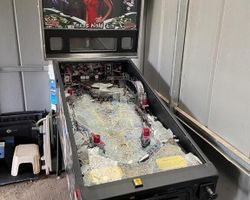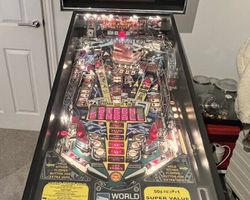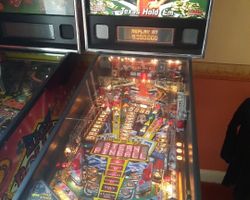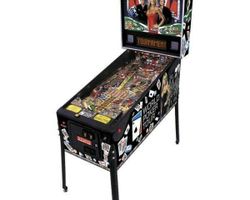World Poker Tour™
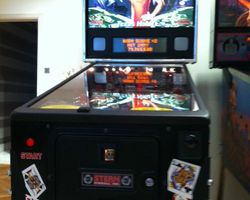
Average Prices: USD $1,900 to $3,400
Produced: Febuary, 2006
Machine Type: Solid State Electronic
MPU: Stern S.A.M. Board System
Players: 4
Design by: Steve Ritchie, Keith P. Johnson
Art by: Keith P. Johnson, Brian Rood
Dots/Animation by: Mark Galvez
Music by: Chris Granner
Sound by: Chris Granner
Software by: Dwight Sullivan, Keith P. Johnson
The launch of the World Poker Tour pinball machine in February 2006 marked a notable moment for Stern Pinball, Inc. As a licensed title, it capitalized on the surging popularity of televised poker during the mid-2000s, bringing the excitement of high-stakes Texas Hold 'Em to the pinball playfield. The machine was designed by Steve Ritchie, a designer known for his fast, flowing layouts and demanding shot geometries. This project saw Ritchie collaborate with a talented team: Dwight Sullivan and Keith P. Johnson handled the software development, Chris Granner composed the music and sound design, Mark Galvez created the animations, and Brian Rood was responsible for the playfield and cabinet artwork. World Poker Tour holds a significant place in pinball history as the inaugural game to utilize Stern's then-new S.A.M. System, an advanced hardware platform that would underpin many of Stern's subsequent machines. With a production run of approximately 3,000 units, it established a foundation for future Stern titles. The cabinet itself was advertised with generous dimensions, measuring 55 inches long, 27 inches wide, and 75.5 inches high, weighing 250 pounds, emphasizing a robust presence in any game room or arcade.
Signature Features and Design
World Poker Tour is distinguished by several key features that integrate the poker theme into its physical design and gameplay. The machine boasts a multi-leveled playfield, a prominent element that immediately sets it apart. This upper playfield is cleverly designed to represent a poker table, complete with card inserts and targets, providing a distinct area for players to aim for and interact with. The game includes 16 drop targets, an unusually high number for a modern pinball machine, which are arranged in various banks across the playfield. These drop targets serve as a primary means of progression, simulating the collection of cards or chips. There are two main ramps that provide satisfying, high-speed shots, contributing to the overall flow and pace. Four flippers are present, with two standard lower flippers and two additional flippers dedicated to accessing the upper playfield and specific shots. Three pop bumpers, strategically placed, keep the ball active and unpredictable, adding an element of chance akin to a poker game. Spinners also feature, increasing shot value and contributing to the feeling of a fast-paced game. The playfield artwork by Brian Rood is centered around the poker theme, incorporating card suits, poker chips, and elements from the World Poker Tour branding. While some found the art style to be functional rather than overtly flashy, it effectively conveys the casino atmosphere and the competitive spirit of poker.
Playfield and Mechanics
The playfield layout of World Poker Tour, characteristic of Steve Ritchie's designs, emphasizes speed and flow. From the manual and automatic plunger, players are launched into an open design that encourages continuous ball movement. Key shots include the two main ramps, which are critical for building scores and advancing modes. The extensive array of 16 drop targets is a central mechanical feature. These are often arranged into banks, such as the two banks of three targets that, when completed, help build poker hands. Another significant target is the central "Pot" scoop, which initiates modes and multiball phases.
The upper playfield is a unique area, accessible via a shot from the lower playfield. This "poker table" features its own set of targets and a dedicated flipper, offering distinct shot opportunities and strategic depth. Successful shots on the upper playfield often contribute to building poker hands or collecting bonus chips. The design philosophy behind this layout is to provide a fast, rewarding experience with multiple strategic pathways. Players can choose to focus on completing drop targets for poker hands, hitting ramps for quick points, or aiming for the upper playfield for higher-value rewards. The lighting on the playfield, while not as elaborate as later LED-driven machines, effectively guides players to active shots and highlights progression towards game objectives. The artwork, while evoking the poker theme, maintains clarity in depicting shot targets and rules, ensuring that players can easily identify their next objective.
Gameplay Dynamics
The World Poker Tour pinball machine integrates the strategy and terminology of Texas Hold 'Em poker into its core gameplay. The primary objective is to build the best possible poker hands by hitting various targets and completing specific sequences. For instance, completing banks of drop targets can "deal" players a card, progressing them towards a full five-card hand. As players build stronger hands, they unlock higher scoring opportunities and advance through rounds of a virtual poker tournament.
Multiball is a crucial element, with four distinct multiball modes available. Each multiball is typically initiated by completing specific objectives, such as hitting the "Pot" scoop or clearing certain target banks. These multiballs provide a frenetic scoring opportunity, as players attempt to keep multiple balls in play while hitting jackpot targets. Unique modes are themed around poker concepts, such as "Cash Game," "Tournament Play," and "Final Table." During "Cash Game" modes, players collect virtual chips by hitting various shots. "Tournament Play" challenges players to achieve specific scores or complete a series of shots within a time limit, simulating the pressure of a tournament round. The ultimate goal is often to reach the "Final Table," where the stakes are highest, and large scores can be accumulated. The custom speech, featuring voiceovers from World Poker Tour hosts, enhances the theme integration, guiding players through the game with familiar poker commentary. Strategic gameplay involves balancing the pursuit of poker hands with the activation of multiballs and the completion of various modes. Some players prioritize completing drop targets to secure valuable poker hands, while others focus on quickly activating multiballs for rapid scoring. The game offers a layered progression that rewards both precise shot-making and an understanding of the poker-based ruleset, creating a replayable experience as players strive for higher scores and better poker outcomes.
Reception and Legacy
The World Poker Tour pinball machine elicited varied responses within the pinball community, though the overall sentiment leans positive for its gameplay. A common point of praise centered on the machine's engaging and fun gameplay. Many found it to be fast-paced, flowing well, and consistently challenging, encouraging players to return for repeated games. The ruleset, particularly, was frequently cited as deep and rewarding, offering multiple avenues for progression and strategic depth, which contributed to its high replayability. Players appreciated the satisfying shots and the open playfield layout, characteristic of its designer. The inclusion of numerous drop targets was a welcome feature for many, adding a tactile element and specific shot challenges. The multi-leveled upper playfield was generally well-received, adding a unique dimension and variety to the shot opportunities. The integration of the poker theme was another strong point, with many commending how the game successfully translated poker elements, such as building hands and tournament progression, into pinball objectives, enhanced by the custom voiceovers. Its value proposition was also noted; many considered it a well-featured game for its market position.
However, the machine was not without its criticisms, primarily focused on its aesthetics. The backglass, or translite, was consistently singled out for being uninspired, poorly designed, or simply forgettable, and the cabinet art was often described as average. Some found the playfield art to appear basic or dated, detracting from the overall visual appeal. While the rules were deep, some players, particularly casual ones, found the complexity overwhelming, making it difficult to fully grasp the game's objectives without consulting a rule sheet. A minor point of contention for some was a perceived "cheap" or "flimsy" feel in the machine's build quality. Despite these visual and minor tactile drawbacks, the addictive nature of the gameplay often outweighed the aesthetic concerns for many players, leading to a largely positive overall reception. World Poker Tour's most enduring legacy lies in its pioneering role as the first Stern game to implement the S.A.M. System. This technological leap set the stage for a new generation of Stern machines, allowing for more complex programming, improved sound, and enhanced display capabilities. This technological foundation, combined with its engaging gameplay, solidified its place as a "player's game" in the Stern catalog, often regarded as underrated by enthusiasts who prioritized playability over visual polish.
Sponsored Links
 Ebay Listings
Ebay Listings
 Auction Results
Auction Results
| Cost | Location | Date |
|---|---|---|
| USD $5,200 |  Oregon, United States Oregon, United States |
18 September, 2025 |
| USD $3,500 |  Washington, United States Washington, United States |
07 September, 2025 |
| USD $3,200 |  Washington, United States Washington, United States |
27 June, 2025 |
| USD $3,850 |  Florida, United States Florida, United States |
21 September, 2024 |
| GBP £2,139 |  Dursley, United Kingdom Dursley, United Kingdom |
12 September, 2024 |
| GBP £2,850 |  Ipswich, United Kingdom Ipswich, United Kingdom |
01 July, 2024 |
| USD $3,500 |  Rhode Island, United States Rhode Island, United States |
02 May, 2024 |
| USD $3,500 |  California, United States California, United States |
02 August, 2023 |
| USD $2,299 |  Illinois, United States Illinois, United States |
18 May, 2023 |
| GBP £2,682 |  United Kingdom United Kingdom |
30 April, 2023 |


Private Policy · Search Website · Contact Us
As an eBay Partner, we may earn a commission from qualifying purchases made through links on this site, at no additional cost to you.
All trademarks and copyrighted materials remain property of their respective owners. All other content copyright 2007 - 2025 Pinpedia.

